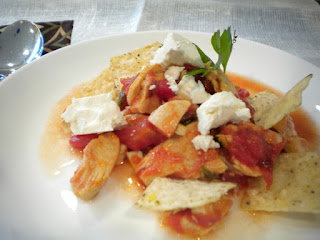I’ll take a break from sharing my best holiday cookie recipes to post about one of my new favorite dinners: chilaquiles. It’s a traditional Mexican recipe, designed to use up leftovers (tortillas, cooked chicken and such). It’s warm, spicy, cheesy and comforting … perfect for these dark, Midwestern early-winter evenings.
I often have the basic ingredients on hand (and would encourage you to do so as well). There’s grilled or roast chicken in quart zip-top bags in the freezer; a can of tomatoes in the pantry. The only unusual ingredient here is chipotle chilies in adobo sauce. You can purchase these in small cans at any grocery store, and store what you don’t use in a lidded jar in the refrigerator (they’ll keep for weeks). The slightly stale, crumbly bits leftover at the bottom of a bag of tortilla chips are perfectly serviceable as the base for this dish.
MEXICAN CHILAQUILES RECIPE
(adapted from Everyday Food; serves 2 and can easily be doubled)
2 cloves garlic, minced
1 15-ounce can diced tomatoes
1 chipotle chile, minced (remove seeds if you want to lessen the heat; see Note)
1 tsp. adobo sauce (from the can of chiles)
1 large chicken boneless chicken breast half, cooked and shredded (or use about 2 cups of shredded chicken from a store-bought roasted bird)
1/4 cup fresh cilantro leaves and tender stems (lightly packed), chopped
1 cup tortilla chips
low-fat feta cheese, non-fat Greek yogurt and additional cilantro leaves for serving
1 15-ounce can diced tomatoes
1 chipotle chile, minced (remove seeds if you want to lessen the heat; see Note)
1 tsp. adobo sauce (from the can of chiles)
1 large chicken boneless chicken breast half, cooked and shredded (or use about 2 cups of shredded chicken from a store-bought roasted bird)
1/4 cup fresh cilantro leaves and tender stems (lightly packed), chopped
1 cup tortilla chips
low-fat feta cheese, non-fat Greek yogurt and additional cilantro leaves for serving
Note: If you don’t have chipotle chiles on hand, add heat and spice with alternative ingredients. Try a blend of chili powder, cumin and a pinch of cayenne.
In a medium saucepan, sauté garlic cloves in a bit of olive oil until fragrant. Add tomatoes, chiles, adobo sauce; fill the tomato can half-full of water and add that to the pan. Bring to a light boil, then reduce heat and simmer for about 10 minutes until the sauce begins to thicken slightly. Add chicken and continue cooking until it’s warmed through, then add cilantro and remove the pan from the heat. Divide tortilla chips in two deep plates or shallow bowls; spoon chicken mixture over. Top with crumbled feta cheese, sour cream and additional cilantro if desired.
source: http://writes4food.com







